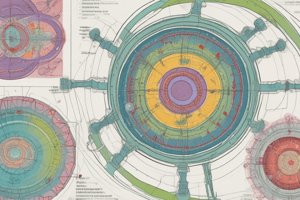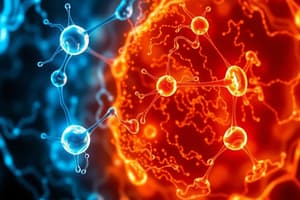Podcast
Questions and Answers
What is the primary purpose of a convolutional layer in a Convolutional Neural Network (CNN)?
What is the primary purpose of a convolutional layer in a Convolutional Neural Network (CNN)?
- To detect local patterns and features in the input data. (correct)
- To globally connect all neurons between layers.
- To introduce non-linearity into the model.
- To reduce the dimensionality of the input data.
Which of the following activation functions is commonly used in the output layer of a CNN for multi-class classification problems?
Which of the following activation functions is commonly used in the output layer of a CNN for multi-class classification problems?
- ReLU
- Sigmoid
- Softmax (correct)
- Tanh
Why is max pooling often applied after a convolutional layer in a CNN?
Why is max pooling often applied after a convolutional layer in a CNN?
- To increase the spatial resolution of the feature maps.
- To reduce the computational cost and extract dominant features. (correct)
- To introduce non-linearity into the network.
- To prevent overfitting by increasing the number of parameters.
What is the role of the 'stride' parameter in a convolutional layer?
What is the role of the 'stride' parameter in a convolutional layer?
Consider a CNN with the following layers: Convolutional Layer (32 filters, 3x3 kernel), ReLU activation, Max Pooling (2x2), and a Fully Connected Layer. If the input image is 28x28 pixels, what is the purpose of the fully connected layer?
Consider a CNN with the following layers: Convolutional Layer (32 filters, 3x3 kernel), ReLU activation, Max Pooling (2x2), and a Fully Connected Layer. If the input image is 28x28 pixels, what is the purpose of the fully connected layer?
Flashcards
Otoscopy
Otoscopy
Visual examination of the ear canal and eardrum using an otoscope.
Audiometry
Audiometry
Measurement of hearing sensitivity at different frequencies.
Tympanometry
Tympanometry
Test that measures middle ear function and eardrum mobility.
Auditory Brainstem Response (ABR)
Auditory Brainstem Response (ABR)
Signup and view all the flashcards
Electronystagmography (ENG)
Electronystagmography (ENG)
Signup and view all the flashcards
Study Notes
- Cell division and cell cycle continue through lectures.
- Cyclins are proteins that activate cyclin-dependent kinases (CDKs) to control cell cycle transitions.
- Cyclin levels rise and fall at specific phases.
Cyclins and Cell Cycle Progression
- Cell cycle progression necessitates cyclins and cyclin-dependent kinases (CDKs).
- Over 10 types of cyclins enable CDKs to function, closely associated with cell cycle progression.
-
20 different types of CDKs all have conserved structures.
- CDK can phosphorylate hundreds of target proteins at serine/threonine residues once bound to cyclin.
- Phosphorylation by CDK enables specific steps of the cell cycle, as well as other cellular functions such as transcription and splicing.
- Cells cycle continuously from S phase (replication) to the G (gap) phase.
- An important class of proteins that control the cell cycle are protein complexes called CDKs.
- Cyclin-dependent kinase proteins have kinase activity that can phosphorylate other proteins.
- Phosphorylation changes the activity of other proteins.
- Any amino group that contains a hydroxy group can be phosphorylated.
- Cyclin levels are highest during G1, transition into S phase, and then flat lines into G2.
- Specificity of the CDK is achieved through cyclin binding and substrate recognition.
- Cyclins give specificity to CDK and trigger the transition for the phases.
Cell Division Decision Points
- Checkpoints in the cell cycle ensure fidelity of the previous step.
- At the G1 checkpoint, the cell checks for sufficient size and proper signals to duplicate chromosomes and centrosomes.
- At the S phase entry checkpoint ("start"), the cell duplicates chromosomes and centrosomes.
- At the G2 checkpoint, the cell checks if the chromosomes have been completely duplicated, thereby entering mitosis.
- Throughout interphase there is ongoing protein synthesis and cell growth.
- At the Mitotic entry checkpoint, Enter mitosis.
- At the spindle assembly checkpoint, cells check if all chromosomes have arrived and aligned at the metaphase plate, and initiates anaphase.
- Commitment to entering the cell cycle occurs once you have passed the start.
- Cells decide whether to proceed through cell division based on having enough goods to split into 2 cells and having received proper signals from the environment.
Cell Cycle Entry
- Cell cycle re-entry typically depends on growth factors, such as ligands that activate the receptor tyrosine kinase (RTK) pathway.
- Autophosphorylation occurs when these receptors bind to a particular ligand.
- Knowing what guides cell cycling is important when discussing cell signaling.
Cell Cycle Progression and S Phase Initiation
- Transition is required from G1 to S where DNA replication can occur.
- Retinoblastoma (Rb) proteins are phosphorylated by G1/S cyclins.
- E2F transcription factor, which regulates genes, is released by phosphorylated Rb and are needed for DNA synthesis.
- Cyclins bind to CDKs
- Cyclin-CDK complexes become active go on and phosphorylate (change activity) of their targets, like E2F.
- E2F promotes the transcription of genes required for S-phase entry and has to be active in order for DNA to be synthesized.
- Retinoblastoma protein (Rb) normally keeps E2F inactive.
- Cyclin-CDK complexes phosphorylate Rb which causes it to release E2F, allowing it to activate the transcription of DNA synthesis genes.
- If there is a dysfunctional retinoblastoma protein there would be constitutive transcriptional activation of E2F, leading to uncontrolled cell cycle progression and potential tumorigenesis.
Cell Cycle Checkpoints
- The mitotic entry checkpoint is guarded by p53.
Spindle Assembly Checkpoint
- After chromosomes are replicated, the two sister chromatids get held together by cohesins, which is important during mitosis.
- The spindle assembly checkpoint monitors kinetochore attachment.
- It's important that the cell doesn't continue dividing after the checkpoint.
Mad2 and APC
- Mad2 is a spindle checkpoint protein that inhibits the APC (anaphase promoting complex).
- Mad2 is a protein that regulates the spindle checkpoint and prevents the cell from transitioning from metaphase to anaphase too early.
- Mad2 inhibits the activity of a complex to keep sister chromatids attached.
- M-cyclin has high activity during G2 into M, which triggers you into mitosis.
Meiosis
- Essential for gametogenesis is halving chromosome number.
- Chromosomes replicate once (like mitosis), whereas cells divide its DNA content twice (unlike mitosis)
- Genetic diversity of gametes is increased through independent assortment of chromosomes and crossing-over between homologous chromosomes.
- Meiosis happens in somatic cells - cells in the body
- Happens in the gonad, the part of the reproductive system that produces and releases eggs (ovary) or sperm (testicle/testis)
- Split chromosomes twice 4n -> 2n -> n
- Recombination of genetic material increases genetic material through Crossing over and independent assortment.
- The chromosome in the picture has already gone through S phase because it's attached to it's sister. For ex: these two chromosomes can be referred to as chromosome #6s. 2 homologous chromosomes.
Genetic Diversity
- Genetic diversity is generated during meiosis in two ways.
- In this example, there are 4 chromosomes/2 pairs.
- A and a are homologues, as are B and b.
- Maternal chromosomes (AB) and paternal chromosomes (ab) alignment.
- A cell with 2 chromosomes: dark green and light green are homologous, while dark red and light red are homogenes.
- The cell has entered meiosis
- In metaphase plate, the chromosomes stay together on the plate while aligning.
- Align in different orientation
Studying That Suits You
Use AI to generate personalized quizzes and flashcards to suit your learning preferences.



